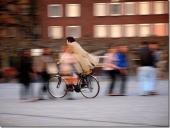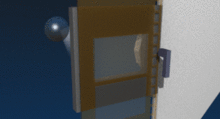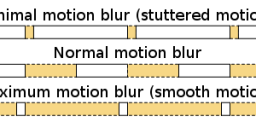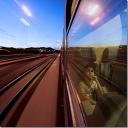
-
Isn't this what LPowell refers to as "farkle" ??... High contrast edges strobing when panned.
http://personal-view.com/talks/discussion/comment/8788#Comment_8788
-
Yes, I know it's a compression artefact. It only appears on a few frames. Both screen grabs are paused. I'm quite sure it has nothing to do with the stuttering people are reporting. I originally intended only to show you what each frame of good motion blur looks like. That movement across the frame cannot be achieved by soft-focus alone.
-
Are those artefacts only in a few frames or in all frames when in pause mode? From all I know this is caused by high compressing codecs: not all the information needed for a full frame is available for every frame - thus causing artefacts when displaying one of them (there's only data for the parts where there are changes within the frame while not changing parts of the frame still are there from previous frames). And just out of curiousity: How did you take the screenshot without artefacts (not paused)?
-
FWIW, I tried an outside pan today. Plays back without stutter in spite of blocky artefacts during fastest part of pan - which are surprisingly visible only in pause mode. See correct motion-blur at left, artefact grab at right. Note: normally this sort of glitch would mess up the shot and it's unacceptable of course, Maybe VLC fell back to some error-correction mode and managed to play it smoothly anyway.

 smooth.png960 x 540 - 188K
smooth.png960 x 540 - 188K
 BlockyArtefacts.png683 x 384 - 203K
BlockyArtefacts.png683 x 384 - 203K -
@roberto: I was surprised if his outdoor shots had no blur at all - if the panning wasn't really, really slow. Whereas the inside shots probably look a bit blurred in the first place due to worse lighting (compared to the outside shot).
-
Are the outside-shot frames motion-blurred ? [Does anyone know if there is any meta data in GH2 video file(s) which might show the shutter speed?]
-
@mo7ies Erm...: more light - better/sharper image opposite to less light - less sharpe but more blurred/grained picture in the first place for stills. So why shouldn't this also apply to film?! I'm not wondering about your findings - for me this totaly makes sense.
-
Well, cam was in Manual mode, and I never saw 1/40 shutter change during recording - rather, it stayed the same as it should.
So if you look at the values as reported by camera's display, shutter should be the same throughout.
-
Since you've locked in Aperture and ISO, is it possible that outdoors, the camera is over-riding shutter speed as its only way of getting the exposure right?
Do the individual outdoor frames look motion-blurred?
Thanks for the testing.
-
Here's more info on this topic. I shot some videos today indoors and outdoors.
Shutter always 1/40 to try and force a bit more of the motion blur so to alleviate the strobe.
Lens 14-42mm stock.
Hack Sanity 4.1
Aperture:
Indoors with f5.6 ISO 1600.
Outdoors with f22 ISO 160.
Guess what, none of the indoor footage shows any unpleasant strobing motion; but the outdoor footage does.
It's almost like the strobe depends on how much light hits the lens.
How would you interpret this?
-
Yes indeed, either the cyclist or the background gets blurred. So @balazer, have you looked at your stutter shots, frame-by-frame yet? Personally, this consistently stuttering footage, visible in whatever viewer it's played on, is something I've yet to reproduce. [what I do get is momentary glitches; another thing entirely]. My current shots show quite even motion-blur. So I'm afraid I don't qualify for this experiment!
-
In that shot, clearly the camera is panning to track the motion of the cyclist, resulting in blurring of the background instead of the subject.
I've seen nothing to suggest that the GH2's shutter isn't performing exactly as expected. I've seen stutter and I've seen blur. Increasing the exposure time increases the motion blur, nearly up to 360 degrees.
-
@balazer If you can reproduce this stutter yourself, please try looking at consecutive frames for blur. If it's not motion-blurred (e.g. smeared laterally in a pan), the shutter may well be set to 50 but you're not getting 50. A cyclist travelling at 20 kph will move 10 centimetres during that exposure and the smear should record that movement.
@ everybody
We need testers here - one thing at a time. Task 1: to examine consecutive frames of stuttering 24p footage for blurring. [The previous thread on this topic got bogged down with valid but piecemeal tests, opinion & anecdote].
The first one to win a "Dr Karl Triple-J fun-pack *" for experimentation has been @mo7ies . (thanks!)
* Australia's Dr Karl (AKA "an answer looking for a question") answers listeners' science questions on radio 2JJJ and gives token prizes for real experimentation. - http://en.wikipedia.org/wiki/Karl_Kruszelnicki

 motion-blur-photos-11.jpg504 x 379 - 48K
motion-blur-photos-11.jpg504 x 379 - 48K -
Roberto, that's not the case. We can get close to a 360-degree shutter in the GH2. And shooting in 60p does indeed help a lot.
-
If it's the case that the camera can't get its shutter open early enough or hold it open long enough to blur the motion, then just throwing higher fps at the problem isn't going to be the answer.
-
Or maybe 16mm film.
Yep, silver halide doesn't wait around. As soon as a film camera's gate opens to fast movement outside, light starts painting those beautiful blurry smears across that emulsion.
from Wikipedia: "The primary reason that cinematographers adjust the shutter angle is to control the amount of motion blur that is recorded on each successive frame of film. A tight shutter angle will constrict motion blur. A wide shutter angle will allow it. A 180° shutter angle is considered normal. ..Tight shutters create a stuttering stop motion animation look.."

 220px-Moviecam_schematic_animation.gif220 x 119 - 65K
220px-Moviecam_schematic_animation.gif220 x 119 - 65K
 500px-Time-lapse_exposure_time.svg.png500 x 150 - 6K
500px-Time-lapse_exposure_time.svg.png500 x 150 - 6K -
Guys, it is time to shoot at 60p :-) ,,,,,,,,,,,
Or maybe 16mm film.
-
Guys, it is time to shoot at 60p :-)
-
Why would you want to blur your beautiful images from the GH2 to control this?
- Because that's what our eyes register when we see lots of detail pass us by: a blur !
Once a camera has reduced all that data into a limited number of un-blurred static pictures, we perceive the whole as a series of staccato pictures.

 motion-blur-photos-32_thumb.jpg504 x 504 - 68K
motion-blur-photos-32_thumb.jpg504 x 504 - 68K -
RED cameras exaggerate them even more. It's sharpness. If you want something soft, get a 5D or 7D ;-)
-
It was already mentioned that GH2 exaggerates the usual artifacts of 24p, and we are looking for the ways to alleviate that.
-
Blur? Just slower pans ;-)
Folks, this issue has been with us since movies were shot in 24 fps and will go away when we switch to 48 fps!
Why would you want to blur your beautiful images from the GH2 to control this? Follow the panning rules from the American Cinematographer's Manual and you'll be OK.
Plus, with the narrow DOF we can get from any large sensor camera, whenever you are doing a guided pan/track on a moving object or actor, take care to blur the background. I'll help a lot.
-
OK I read that thread in its entirety, and did some experimentation.
IMHO, adding Lens Blur, Iris Radius 5, in After Effects post does cure the problem on the test footage I had.
So I do agree that the issue has been exaggerated by GH2's incredible sharpness. Mind you, I always shoot at -2 sharpness setting of the camera, but everyone says this does not remove all in-camera sharpening, still.
So I suppose the consensus is, add Blur in post to the particular shots that exhibit strobe/judder effect.
Howdy, Stranger!
It looks like you're new here. If you want to get involved, click one of these buttons!
Categories
- Topics List23,971
- Blog5,724
- General and News1,348
- Hacks and Patches1,153
- ↳ Top Settings33
- ↳ Beginners255
- ↳ Archives402
- ↳ Hacks News and Development56
- Cameras2,359
- ↳ Panasonic990
- ↳ Canon118
- ↳ Sony155
- ↳ Nikon96
- ↳ Pentax and Samsung70
- ↳ Olympus and Fujifilm100
- ↳ Compacts and Camcorders300
- ↳ Smartphones for video97
- ↳ Pro Video Cameras191
- ↳ BlackMagic and other raw cameras116
- Skill1,961
- ↳ Business and distribution66
- ↳ Preparation, scripts and legal38
- ↳ Art149
- ↳ Import, Convert, Exporting291
- ↳ Editors191
- ↳ Effects and stunts115
- ↳ Color grading197
- ↳ Sound and Music280
- ↳ Lighting96
- ↳ Software and storage tips267
- Gear5,414
- ↳ Filters, Adapters, Matte boxes344
- ↳ Lenses1,579
- ↳ Follow focus and gears93
- ↳ Sound498
- ↳ Lighting gear314
- ↳ Camera movement230
- ↳ Gimbals and copters302
- ↳ Rigs and related stuff272
- ↳ Power solutions83
- ↳ Monitors and viewfinders339
- ↳ Tripods and fluid heads139
- ↳ Storage286
- ↳ Computers and studio gear560
- ↳ VR and 3D248
- Showcase1,859
- Marketplace2,834
- Offtopic1,319








